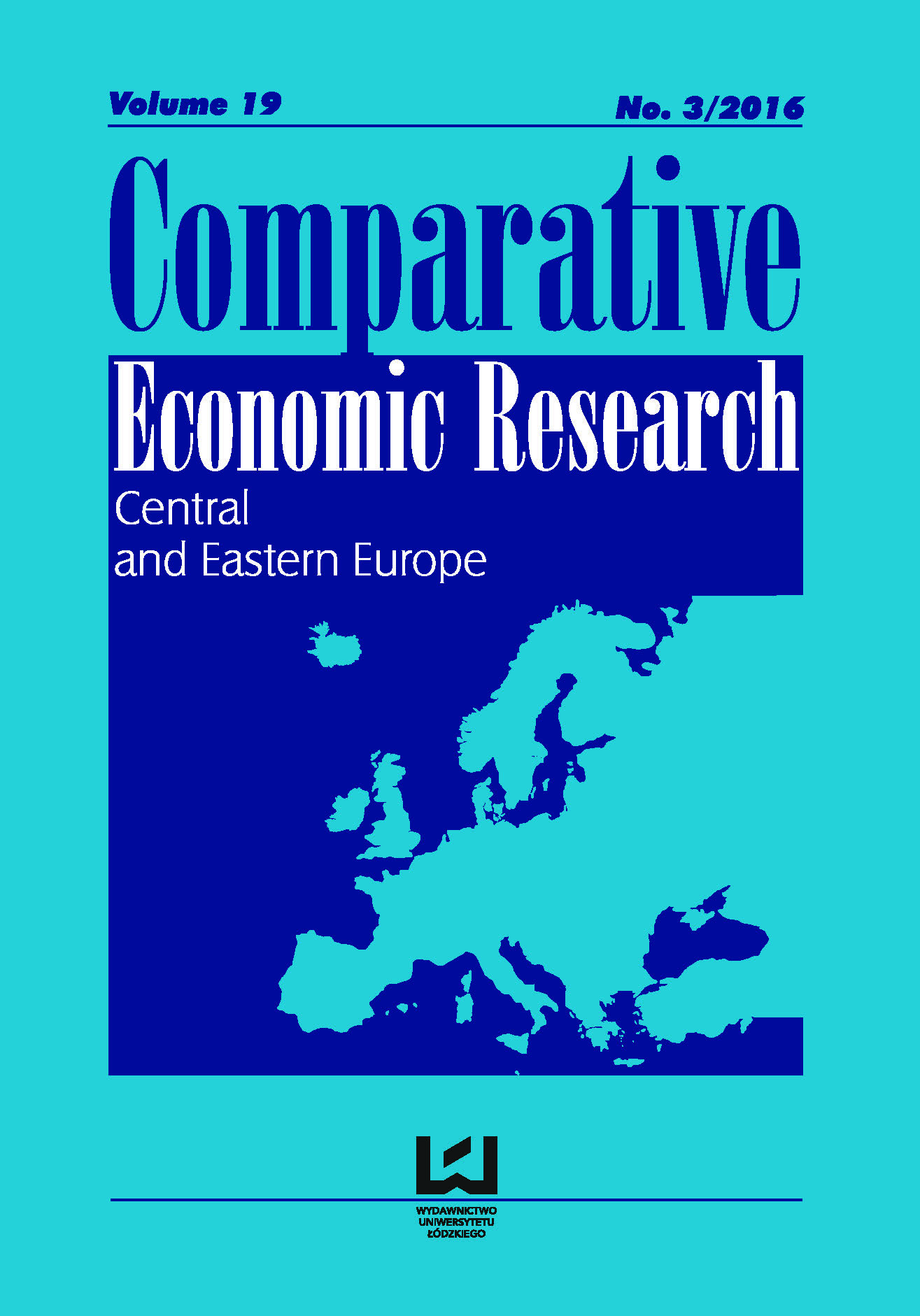The European Union As A Global Economic Power
DOI:
https://doi.org/10.1515/cer-2016-0019Keywords:
European Union, economic growth, productivity, global positionAbstract
The aim of this study is to evaluate the EU economic position in 1995–2014 as well as the prospective growth potential in the global dimension up to 2025. The subject of the research is real and projected data including: GDP growth rate, main growth factors (labour, labour productivity and Total Factor Productivity), and their input to GDP growth, as well as data showing public debts and budget deficits. The analysis was conducted for the years 1995–2014 and 2015–2025. The authors' basic conclusions are:
1) the technological and economic gap between the European Union and the United States has been deepening;
2) the increasing polarisation of world economic powers and low GDP growth in the European Union limit the EU’s chances of maintaining the position as the second centre in the world economy;
3) improving the situation in public finances in the European Union as compared to the US is a factor which could raise GDP growth rates in European countries, however, there are countries whose future is in doubt due to the dramatically poor state of public finances, such as Greece, Italy, Portugal or Ireland;
4) economic growth forecasts indicate a deepening of the economic gap between the largest EU countries and the US.
Downloads
References
AMECO (2015), AMECO – The annual macro-economic database. Retrieved from http://ec.europa.eu/economy_finance/db_indicators/ameco/index_en.htm
Google Scholar
Ark van B., Inklaar R., McGuckin R.H. (2003), ICT and Productivity in Europe and United States. Where Do the Differences Come From?, ‘CESifo Economic Studies’, Vol. 49, No 3.
Google Scholar
Ark van B., O'Mahony M., Timmer M.P. (2008), The productivity Gap between Europe and United States: Trends and Causes, ‘Journal of Economic Perspectives’, Vol. 22, No 1, Winter 2008.
Google Scholar
Barro R., Sala-I-Martin X. (1995), Economic Growth, New York, McGraw-Hill.
Google Scholar
Craft N. (2008), Solow and Growth Accounting: A Perspective from Quantitative Economic History, University of Warwick.
Google Scholar
Easterly W., Levine R. (2001), It's Not Factor Accumulation: Stylized Facts and Growth Models, ‘World Bank Economic Review’, Vol. 15, No. 2.
Google Scholar
EEAG (2002), Report on the European Economy 2002, European Economic Advisory Group CESifo, Munich Germany.
Google Scholar
Erumban A.A., Vries de K. (2014), Projecting Global Economic Growth The Conference Board Global Economic Outlook 2015, The Conference Board, November 2014.
Google Scholar
European Commission (2004), EMU after five years, European Economy. Special Report, No 1.
Google Scholar
European Commission (2013), European Economic Forecast Winter 2013, European Economy, No 1.
Google Scholar
European Commission (2014), European Economic Forecast Winter 2014, European Economy, No 2.
Google Scholar
Fernandez M.J.A., Gonzalez J.U. (2004), Stabilization Policy in EMU: The Case for More Active Fiscal Policy, ‘Serie de Collection de Informes del Observatorio de Economia Europea del Instituto de Studios Europeos’, No 3, Madrid, Dicembre de 2004.
Google Scholar
Fouré J., Bénassy-Quéré A., Fontagné L. (2010), The world economy in 2050: a tentative picture, ‘CEPII Working Papers’, No. 2010–27.
Google Scholar
Gomez-Salvador R., Musso A., Stocker M., Turunen J. (2006), Labour Productivity Development in the Euro Area, ‘ECB Occasional Paper Series’, No 53, October 2006.
Google Scholar
Hanushek E., Kimko D. (2000), Schooling, Labor-Force Quality, and the Growth of Nations, ‘American Economic Review’, 90.
Google Scholar
Mucha-Leszko B. (2007), Strefa euro, wprowadzanie, funkcjonowanie, międzynarodowa rola euro, Wyd. UMCS, Lublin.
Google Scholar
Mucha-Leszko B. (2013), Możliwości zmniejszenia luki rozwojowej Polski w Unii Europejskiej i wobec krajów o największym potencjale gospodarczym w perspektywie 2040 roku, ‘Zeszyty Naukowe’ nr 756. Finanse, Rynki finansowe, Ubezpieczenia nr 57. Miejsce Polski w gospodarce światowej, Uniwersytet Szczeciński.
Google Scholar
Mucha-Leszko B., Kąkol M. (2011), Portugalia w unii walutowej – problemy gospodarcze i kryzys finansów publicznych, ‘Ekonomista’, No 4, Warszawa.
Google Scholar
OECD (2014), ‘OECD Economic Outlook’, Vol. 2014/1, OECD Publishing.
Google Scholar
Petrakos G., Arvanitidis P., Pavleas S. (2007), Determinants of Economic Growth: The Experts’ View. Dynamic Regions in a Knowledge-Driven Global Economy Lessons and Policy Implications for the EU. DYNGER Working Papers 20/2007.
Google Scholar
Sapir A., Aghion P., Bertola G., Hellwig M., Pisani-Ferry J., Rosati D., Viñals J., Wallace H., Buti M., Nava M., Smith P. (2004), An Agenda for a Growing Europe. The Sapir Report, Oxford University Press.
Google Scholar
The Conference Board (2015), Total Economy Database. Retrieved from http://www.conferenceboard.org/data/economydatabase/
Google Scholar
Ulku H. (2004), R&D, Innovation, and Economic Growth: An Empirical Analysis, ‘IMF Working Paper’ 185.
Google Scholar
WTO (2011), International Trade Statistics 2011.
Google Scholar
Downloads
Published
How to Cite
Issue
Section
License

This work is licensed under a Creative Commons Attribution-NonCommercial-NoDerivatives 4.0 International License.











